#Aquamanile
Explore tagged Tumblr posts
Text

Aquamanile in the Form of a Lion
German, ca. 1400
This elaborate water vessel was intended for handwashing. A specialty of metalworkers in German-speaking lands for centuries—from the twelfth to the fifteenth—they are called aquamanilia, from the Latin words for water (aqua) and hand (manus).
250 notes
·
View notes
Text
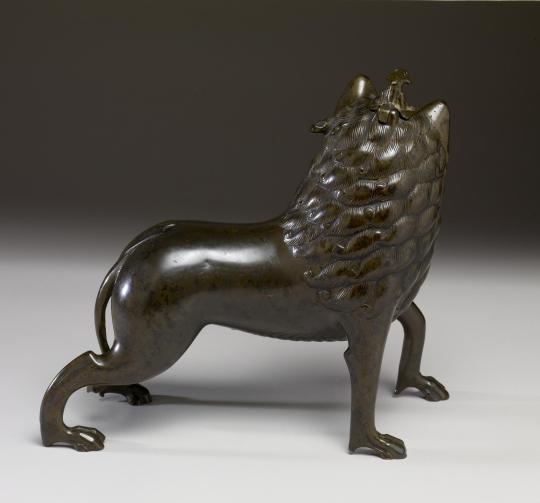

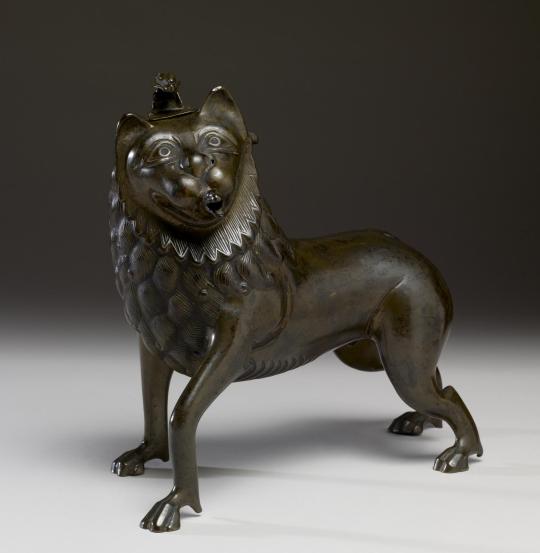

~ Aquamanile in the Form of a Lion.
Artist/Culture: German or Netherlandish
Date: late 13th or early 14th century
Period: Late Medieval
Medium: Brass
▪︎This unusual example bears a Hebrew inscription on one side that reads: (On the side and rear hip of the lion): ברוך אתה ה אלהינו מלך העולם א��ר קדשנו במצוותיו וצוונו על נטילת ידים ; [Translation] Blessed be God, King of the Universe, who blessed us and instructed us to wash our hands (Baruch ata adonai alokhenu meleh Ha-olam asher Ridshanu bemitsvotsar vetsivanu al netilas yadayim).
#13th century#14th century#art#history#museum#medieval#late medieval#Aquamanile#lion#hebrew#German#Netherlandish#inscription
714 notes
·
View notes
Text



These 13th- and 14th-century aquamanilia from the Metropolitan Museum of Art collection on JSTOR (which includes nearly half a million open access images for everyone) are really something else. Our favorite is the one of Aristotle and Phyllis. Sure, the story behind it is as sexist as you may expect, but we prefer to interpret it as the triumph of woman over insufferable mansplainer.
#medieval art#aquamanile#aristotle#aristotle and phyllis#samson and the lion#shut up aristotle#jstor
674 notes
·
View notes
Text
#MetalMonday :

Lion Aquamanile, c.1200–1250
Germany, Lower Saxony, Hildesheim, Gothic period
Bronze: cast, chased, punched
26.4 x 29 x 15 cm (10 3/8 x 11 7/16 x 5 7/8 in.)
On display at The Cleveland Museum of Art 1972.167
“An aquamanile is a water vessel used for washing hands both at church altars and at the dinner tables of upper-class patrons. They often took the form of fantastic beasts such as dragons and unicorns or animals such as horses, birds, dogs, and lions, like this one.”
#animals in art#european art#museum visit#lion#aquamanile#German art#medieval art#bronze#metalwork#sculpture#13th century art#Cleveland Museum of Art#Metal Monday
26 notes
·
View notes
Text

Aquamanile in the Form of Aristotle and Phyllis, Bronze, Quaternary copper alloy, South Netherlands, 14th – 15h century.
source: nobrashfestivity
59 notes
·
View notes
Text


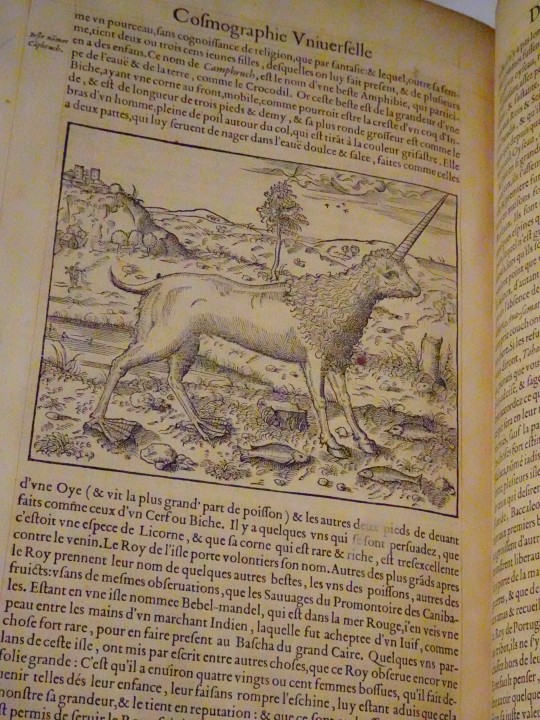




Il y a une petite quinzaine, je suis allé avec Julien et Katie, au Louvre-Lens pour une expo temporaire : “Animaux Fantastiques”. Une très belle expo ! Ici des licornes :
monument pour Renée d'Orléans Longueville, licorne tenant ses armoiries - église des Célestins, Paris, 1515
aquamanile en laiton, licorne - Nuremberg, 1420
André Thévet - "Cosmographie Universelle'" le "camphruch", sorte de licorne amphibie censée vivre en Indonésie - Paris, 1575
dent de narval + bronze et soie - 1600
Maître S.K. - "Orphée jouant du violon devant les animaux"- 1583
Ehrard Reuwich, illustration pour le livre de Bernhard von Breydenbach - ''Pèlerinage en Terre Sainte'' - Mayence, 1502
voir 1
#expo#louvre-lens#animaux fantastiques#monstre#créature#licorne#renée d'orléans longueville#église des célestins#médiéval#renaissance#nuremberg#allemagne#aquamanile#andré thévet#cosmographie#camphruch#narval#défense de narval#maître S.K.#orphée#ehrard reuwich#bernhard von breyendach#mayence
8 notes
·
View notes
Text
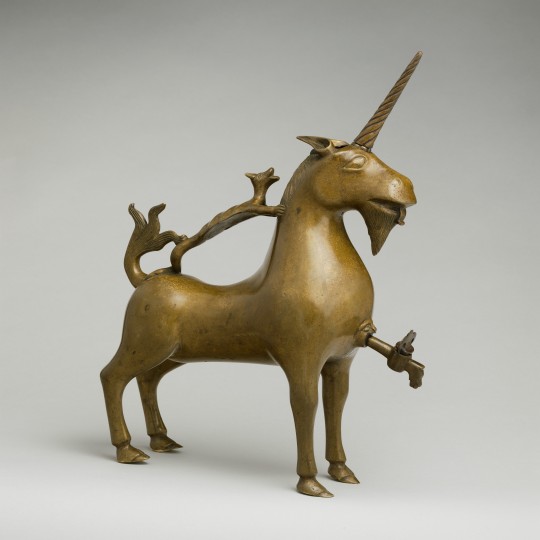
Unicorn Aquamanile, ca. 1425–50
2 notes
·
View notes
Text
Now I need to oogle Phyllis riding Aristotle! Lol

Aquamanile in the Form of Aristotle and Phyllis, Bronze, Quaternary copper alloy, South Netherlandish, 14th – 15h century.
389 notes
·
View notes
Text

Caquesseitão
Aquamanil
século XVII/ prata/China ou Sudoeste da Ásia
Museu do Oriente/Lisboa
in: SAPO viagens
7 notes
·
View notes
Text
Leopard Aquamanile, 16th-19th century Nigeria, (Edo people)
The Leopard Aquamanile, dating back to the 16th-19th century in Nigeria, holds immense cultural and historical significance in the region. This exquisite ceremonial object plays a pivotal role in the traditional Ugie Erha Oba ceremony, where the Oba honors his paternal ancestors. As the Oba prepares for this sacred ritual, he adorns himself in traditional attire before engaging in the symbolic…

View On WordPress
#African American culture#African Art#African History#Leopard Aquamanile#West African#west african art#West African history
1 note
·
View note
Text





Took my beaft stickers to The Met Cloisters to meet their real medieval counterparts.
Artworks Featured:
Basilisk panel from Arch with Beasts, French c. 1150-75
Panther door mount, French early 11th century
Aquamanile in the Form of a Dragon, German c. 1200
Siren detail from Dragon fresco, Spanish after 1200
The Unicorn Rests in a Garden, French/South Netherlandish 1495-1505
(stickers for sale in my shop if you want a beaft to take to the museum)
#beafts#my artwork#art history#the cloisters#museums#medieval art#medieval#bestiary#basilisk#unicorn#siren#dragon#panther (but the bestiary version that has little to do with the real animal)
257 notes
·
View notes
Text

Aquamanile in the Form of a Mounted Knight
German, ca. 1250
Aquamanilia, from the Latin words meaning "water" and "hands," served to pour water over the hands of priests before celebrating Mass and of diners at table. This aquamanile, in the form of a horse and rider, exemplifies the courtly ideals of knighthood that pervaded Western medieval culture and influenced objects intended for daily use. It depicts a type of armor that disappeared toward the third quarter of the thirteenth century. Unfortunately, the shield—which probably displayed the arms of the owner—and the lance are no longer extant.
71 notes
·
View notes
Text
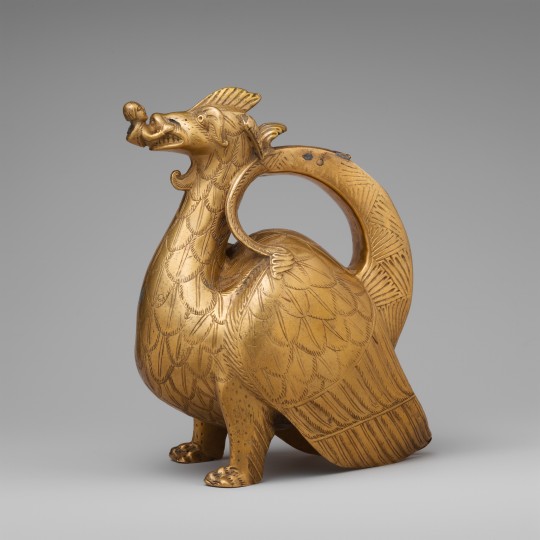
Brass aquamanile in the form of a dragon, Northern Germany, circa 1200
from The Metropolitan Museum of Art
694 notes
·
View notes
Photo

Aquamanile in the Form of a Rooster. 13th century. Credit line: The Cloisters Collection, 1989 https://www.metmuseum.org/art/collection/search/469920
#aesthetic#art#abstract art#art museum#art history#The Metropolitan Museum of Art#museum#museum photography#museum aesthetic#dark academia
42 notes
·
View notes
Text


Aquamanile in the shape of a lion, 12th century. The body of the lion features a later Hebrew inscription, probably added sometime after the mid-16th century, naming Berekhiah Segal as the donor of the vessel to a German synagogue.
Source: The Jewish Museum
28 notes
·
View notes
Text

Aquamanile depicting Phyllis riding Aristotle — a scene from the legend in which Phyllis, Aristotle's lover, humiliates him by riding on his back after he warned Alexander the Great about the dangers of women. Made of copper alloy, this piece originates from the South Lowlands, dating to the 14th-15th century AD.
📸 The MET Museum
#sculpture#art#Aristotle#copper#statue#the metropolitan museum of art#greek mythology#alexander the great
15 notes
·
View notes